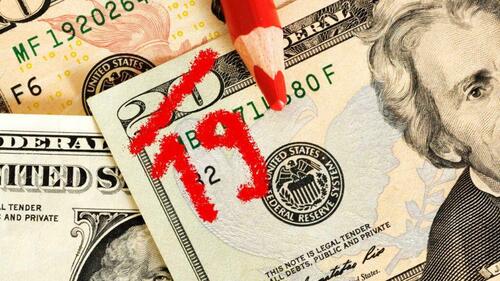Peak Inflation Was A Fairytale Just Like Transitory Inflation
Authored by Michael Maharrey via SchiffGold.com,
Inflation wasn’t transitory.
And inflation hasn’t peaked.
It’s more like peak inflation was transitory.
The May Consumer Price Index (CPI) came in higher than expected. The headline year-on-year price increase was 8.6%. The projection was for the CPI to hold steady at the same level as last month — 8.3%. Instead, we got the biggest jump in prices during this inflationary cycle and the highest CPI print since 1981.
On a month-to-month basis, the CPI rose by 1%. This was above the 0.7% projection. Another spike in fuel and energy costs primarily drove the monthly increase. Energy costs rose 3.9% during the month. Annualized, energy prices are up 34.6%. Fuel oil posted a 16.9% monthly gain, pushing the 12-month surge to 106.7%.
Stripping out more volatile food and energy prices, core CPI rose 0.6%. This equaled last month’s core CPI gain and was double the March core read of 0.3%, which was supposedly signaling peak inflation. If you annualize the last two months, the core CPI would come in at 7.2%.
Year-over-year, core CPI rose 6%. This was slightly above the 5.9% estimate.
Most analysts focus on rising energy prices as the primary driver behind persistent inflation, but prices rose in all 11 CPI categories. Nine of those 11 categories charted price increases above the 12-month average.
Housing costs continue to inch higher, even using the government’s make-believe “owner’s equivalent rent” calculation. The housing index was up another 0.6% on the month and this significantly understates the actual rise in housing costs. It was the fasted one-month gain in shelter costs since 2004. The 5.5% 12-month gain ranks as the biggest rise in housing prices since February 1991,
Americans are feeling the sting of inflation.
According to calculations by Bloomberg Economics, the inflation tax currently costs American households $433 per month. That comes to a $5,200 annual increase in household costs.
Taking into account rising prices, the average consumer took a pay cut from April to May, according to a separate BLS report.
Average hourly earnings rose 0.3%, but real wages fell 0.6%. On a year-on-year basis, real average hourly earnings decreased 3%, seasonally adjusted.
This undercuts the popular narrative that “inflation isn’t really that bad” because wages increase as well. Rising wages don’t keep up with rising prices. As a result, American consumers are running up record levels of debt and burning through savings to make ends meet.
And as bad as these numbers are, it’s actually worse than that. This CPI uses a government formula that understates the actual rise in prices. Based on the CPI formula used in the 1970s, CPI is above 17% — a historically high number.
In March, everybody was talking about peak inflation. Clearly, the CPI didn’t peak in March if it’s higher in May. And there is no reason to think these May numbers will be the peak either.
While the mainstream blames, Russia, COVID, supply chains, excessive demand, and perhaps voodoo for rising inflation, it completely ignores the most significant factor – actual inflation created by the Federal Reserve.
Remember, rising prices are not in and of themselves “inflation.” Inflation is an increase in the money supply. Rising prices are a symptom of inflation. Loose central bank monetary policy drives the money supply up.
The Federal Reserve has been flooding the economy with money — inflation — since 2009. We are drowning in inflation.
The Fed took a weak swing at inflation during its May meeting, raising interest rates by 1/2%. But at .75%, interest rates remain historically low. Meanwhile, the central bank pushed back balance sheet reduction until June. And at the proposed pace, it would take over 7 years to decrease the balance sheet back to pre-pandemic levels. The Federal Reserve hasn’t done nearly enough to mop up all of the excess liquidity in the economy.
As a SchiffGold analyst put it, “This is still highly stimulative, inflationary policy. Interest rates are being held artificially low. And we’re still dealing with all of this inflation that is in the pipeline.”
Meanwhile, President Biden’s inflation-fighting plan basically involves spending more money. That means more borrowing and more debt the Fed will ultimately need to monetize.
It should be clear to you that this won’t fix inflation. In fact, it will only make it worse by raising the inflation tax. Every dollar the government spends comes out of Americans’ pockets — out of your pocket.
If the federal government is going to spend more to fight inflation, it will either have to raise taxes (and not just on the “rich” — that won’t generate enough government revenue) or it will have to borrow more. That means the Federal Reserve will have to print more to monetize the debt. That means more inflation.
All of this tells me that peak inflation was every bit a fairytale as transitory inflation.
Tyler Durden
Tue, 06/14/2022 – 07:20
via ZeroHedge News https://ift.tt/MbGO9ZX Tyler Durden
